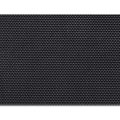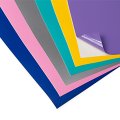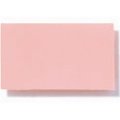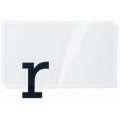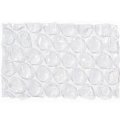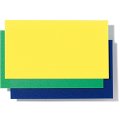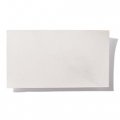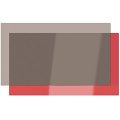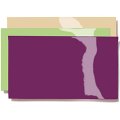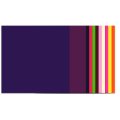Double-Sided Adhesive Film
Information about double sided adhesive filmvv
Application:
Posters, layouts, photographs, blueprints or maps can be firmly attached to suitable surfaces with adhesive film, adhesive with non-woven paper centres or transfer film. All types of panels with smooth surfaces like cardboard, KAPA boards or plastic sheets can serve as the substrate material. Please note: Alternatives to double-sided adhesive films or double-sided adhesive non-woven paper include SPRAY ADHESIVE, TRANSFER ADHESIVE, XYRON adhesive and laminating machines, standard ADHESIVE NON-WOVEN ADHESIVE or GUDY 870, and, finally, self-adhesive panels like, for example, KAPA FIX.
Processing:
Working with the double-sided adhesive film by hand is done as follows: the film is mounted by applying it from one corner to the other and made secure and smooth with the help of a sqeegee-type applicator during which time the the release liner paper is simultaneously and gradually removed as required for exposing the adhesive. Before the PE film liner is removed at a sharp angle, any bubbles should be punctured with a NEEDLE and smoothed out.
The same procedure applies to all the Gudy products. Because, however, only one of their sides has a protective liner, more care must be taken when working on larger areas in order to prevent the adhesive side from sticking to places where it shouldn’t.
Applying your object to the prepared substrate requires a certain amount of dexterity because double-sided adhesive films are very clingy (like plastic wrap). Once the paper has been placed on the film, it must sit perfectly. Large folds or creases cannot be remedied or removed because the paper can no longer be separated from the film. Here too, you can work radially from the middle of a side outwards and do the necessary pressing with a soft brush or cloth.
Further Information about Transfer adhesives:
Transfer adhesives are simply very thin, even layers of adhesive which are lined with silicone paper and self-wound. They are essentially different from double-sided adhesive tape in that transfer adhesives do not have a carrier material; the tape or sheet is pure adhesive that is covered with a liner.
This relatively young technology has immensely simplified two-dimensional bonding in many areas. As a rule, transfer adhesive is applied with roller dispensers in exact lengths. In the process the siliconized protective paper is automatically removed from the adhesive and a thin, immediately adhering film is left behind on the surface to be bonded. In comparison to viscous adhesives or double-sided adhesive tapes and films, transfer adhesives offer a number of advantages:
- exact lengths applied with roller dispensers (no cutting, no picking away at the silicone paper liner)
- fast and easy processing (no painting on, no airing out, no drying time, no additional work after application)
- clean and precise workmanship (no bleeding through, exact positioning, no removal of residue)
- even, thin coat application with a consistent width
- can be used on multi-dimensionally shaped (spherical) surfaces
Bonds made with adhesive transfer tapes are the result of a simple, clean and economic method. Adhesive transfer tapes are not only good for bonding paper, cardboard and photographs or for making presentation charts but are also found being used in the form of very large roller dispensers as professional adhesive systems in industry, office, design studios or in arts and crafts.
Much like thin or viscous adhesives, adhesive transfer films are very versatile and can be used with a large number of materials made of metal, wood, paper and plastic. The very thin types of adhesive (with thicknesses of about 0.05 mm) enable very fine and delicate component parts to be bonded in situations where it is necessary to avoid influencing the construction geometry. Transfer adhesive can be rubbed off of most solid surfaces. Any adhesive that has overlapped during application can be nicely removed in this manner. Transfer adhesives with different features for different uses are available.
